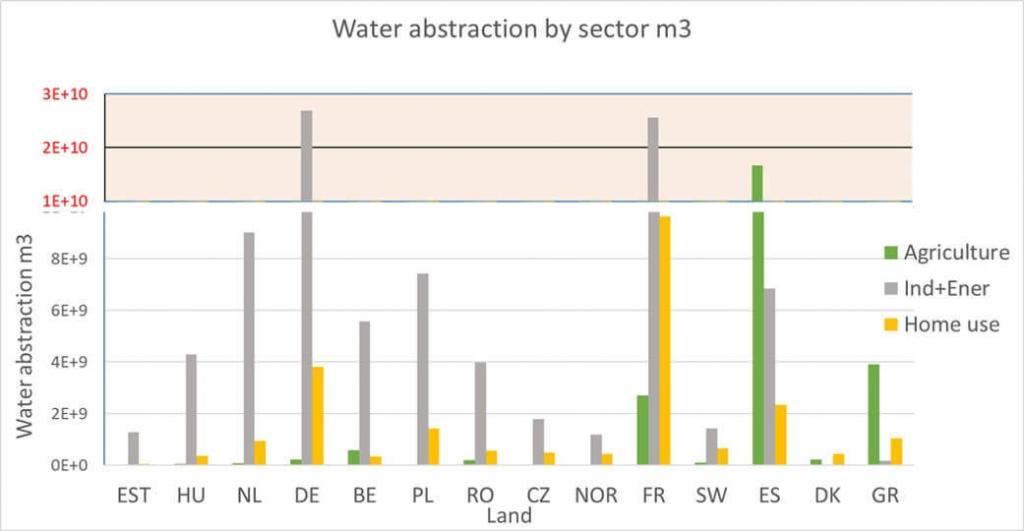Did you know that producing electricity is highly water demanding?
Although fresh water is scarcer than seawater, it is preferred by humans in essentially all of our activities – omitting sea transport and fishing. Fresh water is not only our first choice for agriculture and drinking, but also for energy generation.
In this case though, I am not referring to the hydroelectric power and large dams. Most of the world’s power is generated in thermal powerplants – where heat generated by burning coal or splitting uranium – is used to evaporate steam that drives large turbines. Only about 30% of the thermal energy gets converted into electricity. The rest needs to be dumped into the surroundings by cooling. Most powerplants are iconic for their large cooling towers, which are in fact large heat exchangers, where warm water is sprayed into a fine mist and that causes it to evaporate. The clouds that emerge from the cooling tower are vast amounts of water that need to be extracted from a nearby fresh water source. Just how much water that is might surprise you.
Let’s have a look at the physics
A block of a large nuclear powerplant produces about 1 GWe (GigaWatt electric) of power at full load. Nuclear powerplants run preferentially at full load, as that means the highest efficiency. The efficiency of the “Rankine steam cycle” is about 33% for the pressure water reactors, that means that for every 1GW of electrical power, 2 GW of waste thermal power are generated. As that heat comes from evaporation of water, we need to know the latent heat of evaporation of water to figure out the amount of water that is dumped into the atmosphere. Water leaves the condenser at about 42oC.
Latent heat of vaporization of water at these conditions is about 2,4MJ/Kg. The powerplant produces 2 GJ/s of thermal power, so assuming 100% evaporative cooling efficiency, 2000 / 2,4 = 833 kg/s. Since cooling towers are about 70% efficient in terms of make-up water use, 833/70% = 1190 kg/s. So one block of a nuclear powerplant consumes (evaporates) over a ton of water every second. In one hour of operation this equals to 4.284 tons (cubic meters) and thus 37 billion liters every year- that’s almost 15.000 Olympic swimming pools.
How does water use compare across different sectors?
Water gets used primarily as a coolant in industries. The surprising fact is that most developed nations in Europe mainly use water for cooling, not for households and irrigation, as can be seen in the following figure.

It is clear that the largest water consumers are Germany (DE) and France (FR) and that water gets mostly used by the industry. In Spain (ES) the main use of water is irrigation, however, that’s still 10x less than France or Germany use for cooling.
The relative use of water across domestic, agricultural and industrial sector is shown below.
Apart from Greece, Denmark and Spain, the major water user in Europe is the industry. In the following figure, three major industrial sectors are compared with respect to their water use.
The orange part of the pie chart is power generation, which s also the dominant source of water use. The notable exceptions are Norway, Sweden and Denmark, where renewable sources are mostly used for power generation.
When you open a tap and wash your hands, that water flows from a surface or a ground source back into a nearby river, but when you turn on the light or electric heating, that water evaporates and is carried hundreds of kilometers away by wind, often into another country, maybe even the sea.
The level of water use – which leads to its exclusion from its natural cycles is called the Water Exploitation Index or WEI.
The darker the area the higher the exploitation of water. The river basins of Meuse and Oder reach 67% and 37% respectively, while anything above 20% indicates water stress. The biggest culprit is power generation. What do we do when it stops to rain due to climate change? We will have to turn the power plants off!
There are some ways to reduce this detrimental effect:
- Increase the efficiency of powerplants by increasing steam temperature and pressure – more electricity will be made for each unit of heat wasted
- Use the waste heat elsewhere – for example in district heating, industrial processes or agriculture, so it can dissipate without evaporating water – the issue here is the low water temperature and thus low value of this heat and high cost of its transport.
- Concentrate powerplants close to the sea and use salt water for their cooling. This is of course already in place, but sometimes causes salt to move together with droplets in the plume, wich can cause corrosion and soil pollution. In case the salt could be sorted out, could we actually use them to generate humid air that would keep our continents wetter? But where should we dump the high salt brine?
- If powerplants are located inland, how about using them to evaporate our wastewater -since the order of magnitude of volumes evaporated water and generated wastewater are similar – this could help recover nutrients and other resources from the waste.
…and the list could go on… Do you have any idea or know of any circular economy related application of waste heat? Let me know in the comments.
The data used in the graphs were extracted from these resources.
https://ec.europa.eu/eurostat/statistics-explained/index.php?title=Water_statistics
http://ec.europa.eu/environment/archives/water/adaptation/pdf/InventoryCoolingWaterUse.pdf